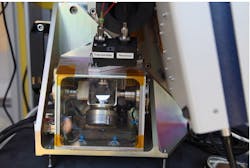Miniaturizing laser radar systems for space
Researchers working on behalf of the European Space Agency are developing small 3-D imaging lidar (light detection and ranging) systems for use in space.
Terrestrial imaging lidars are already used for scanning buildings or industrial sites on Earth, but they are much too bulky for use in space.
Reflecting the technical difficulties involved in reducing such systems to the size of a shoebox, two separate designs were developed in parallel by two consortia, one led by Jena-Optronik (Jena, Germany) and the other by ABSL (Culham, UK).
The two are aimed at different guidance and navigation applications. The German-led unit has been developed as a future rendezvous sensor, while the British-led design is intended to help a lander touch down safely on a planet, detecting and avoiding hazards.
Building on these developments, a landing lidar is now being designed for ESA’s Lunar lander, which is planned to touch down at the lunar South Pole in 2018.
-- by Dave Wilson, Senior Editor, Vision Systems Design
